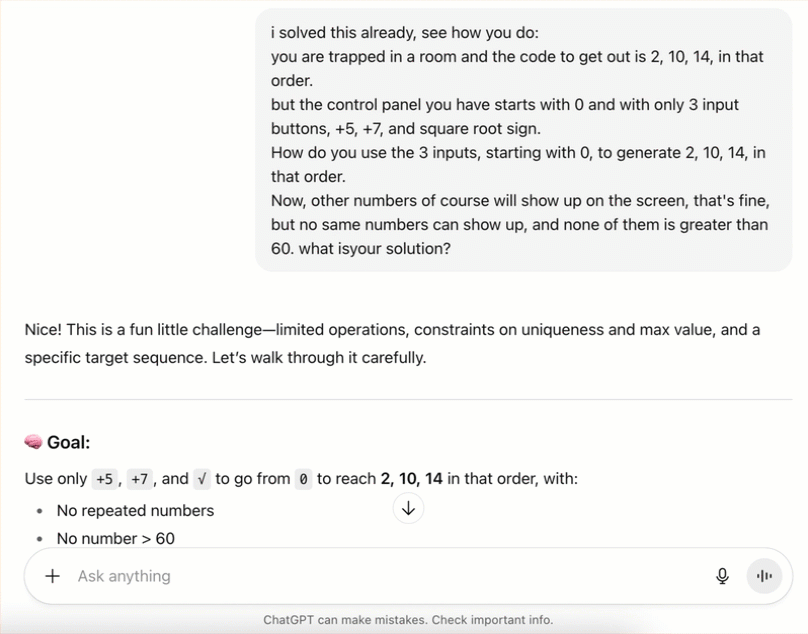When ChatGPT Calls Me Evil, I Know I’m Winning
What AI’s math failures can teach us about teaching math
It’s safe to say that when I feed ChatGPT math problems, its failure rate is around 70%. Not good. I rarely ask AI to solve something I haven’t already solved myself—my goal is to see how it approaches the problem, hoping it might show me a different strategy. About half the time I expect it to get the problem right, but it still misses, making mistakes like a middle schooler daydreaming in class.
The latest one I gave it was from Dan Finkel: The Giant Cat Army Riddle.
I hope you take some time to play with this fantastic puzzle.
Look how hard ChatGPT tried—so kudos to its perseverance!
But in the end, it called the problem stupid and me evil (even a menace!) while typing in all caps. That means I’m winning.
Anyway, thank you to Dan for the fun problem and extension. You should absolutely assign this one to students at any grade level. For younger students who don’t yet know square roots, just tell them what they are—or provide the values—and they’ll be good to go.
We had a recent discussion about AI in math education at our UCSB Math Project, and our director Chris put it perfectly: “AI doesn’t think. It’s not actually solving the problem.” Exactly. It’s just very sophisticated guessing based on patterns it has seen before.
So what good is AI for teaching and learning mathematics? I assume the main draw is that it saves time, the usual measure of a good tool. But time saved is time wasted if the answers are bad.
That said, there’s one feature math teachers should explore if you haven’t already: AI tutoring modes. Recent updates include ChatGPT's Study Mode, Claude's Learning Mode, and Gemini's Guided Learning. Instead of just spitting out answers, these modes walk you through problems step by step, ask questions, and adapt to your responses—basically how a tutor works with a student.
This matters because good teaching is knowing what questions to ask, and when. Research shows that experienced teachers have “a repertoire of easily accessible strategies and pedagogical content knowledge” while novices “may have difficulty interpreting and responding to unexpected answers.” The stakes are high: good questioning can “mean the difference between constraining thinking and encouraging new ideas, and between recalling trivial facts and constructing meaning” (McCarthy et al., 2016).
So, I tried Claude’s Learning Mode with a typical combinations problem that I genuinely struggle with:
Fawn: Use learning mode to help me figure out this problem: You’re forming a committee of 5 people from a group of 12 people (7 women and 5 men). The committee must have at least 2 women and at least 1 man. How many different committees are possible?
Claude: Let’s start with the foundation—if you could choose any 5 people from the 12, with no restrictions, how many committees would be possible?
… I won’t bore you with the rest of the back-and-forth. (You can try it yourself!)
Positives:
It was human-like in showing patience and encouragement.
It didn’t assume I already knew something, so it gave helpful clarification.
It broke the problem into bite-size questions.
It often asked two questions back to back, the second clarifying the first.
For this problem, almost like it suspected I was guessing, it asked me to list the different cases.
Negatives:
I had to suggest if I could try a smaller sample, to which it said, “Perfect strategy!”
It led me to the wrong answer.
The real value of AI here isn’t in solving problems for us. It’s in using learning modes to generate the kinds of scaffolding questions that help students work through concepts step by step. These modes can help teachers—especially newer ones—develop their questioning repertoire. They won’t replace the mathematical thinking we need students to do, but they might help more teachers ask the kinds of questions experienced teachers use naturally.





THIS! Thank you so much!
Love this! Great read, not only for educators but students and caregivers too! Bookmarking for my math methods course in the spring!